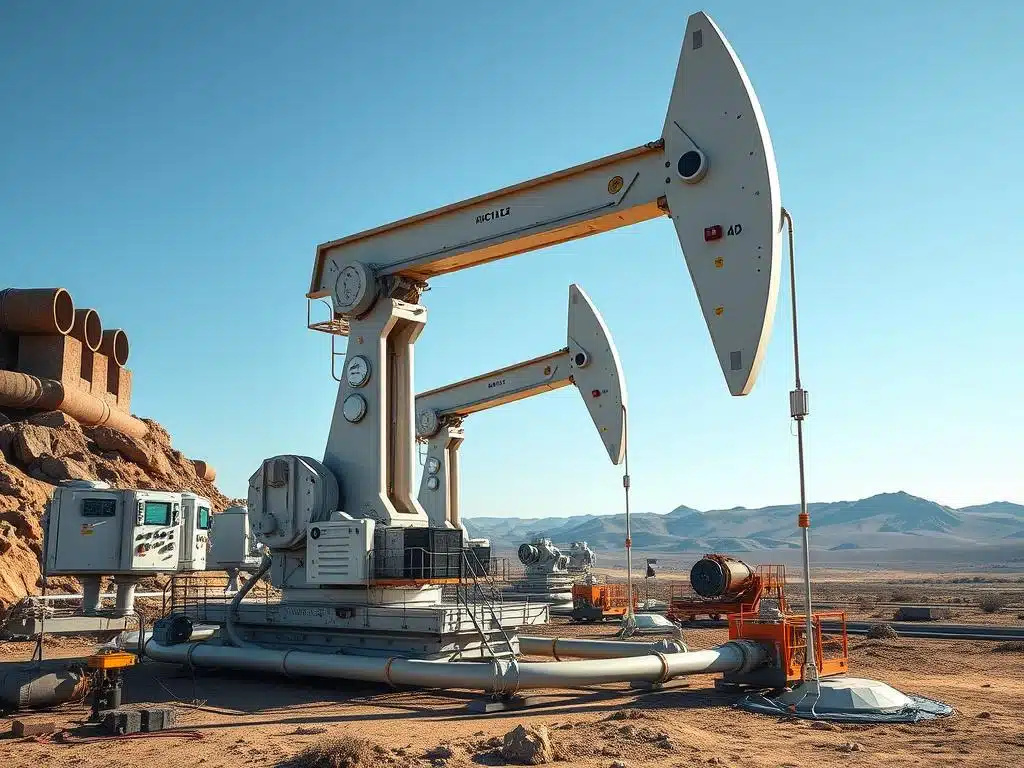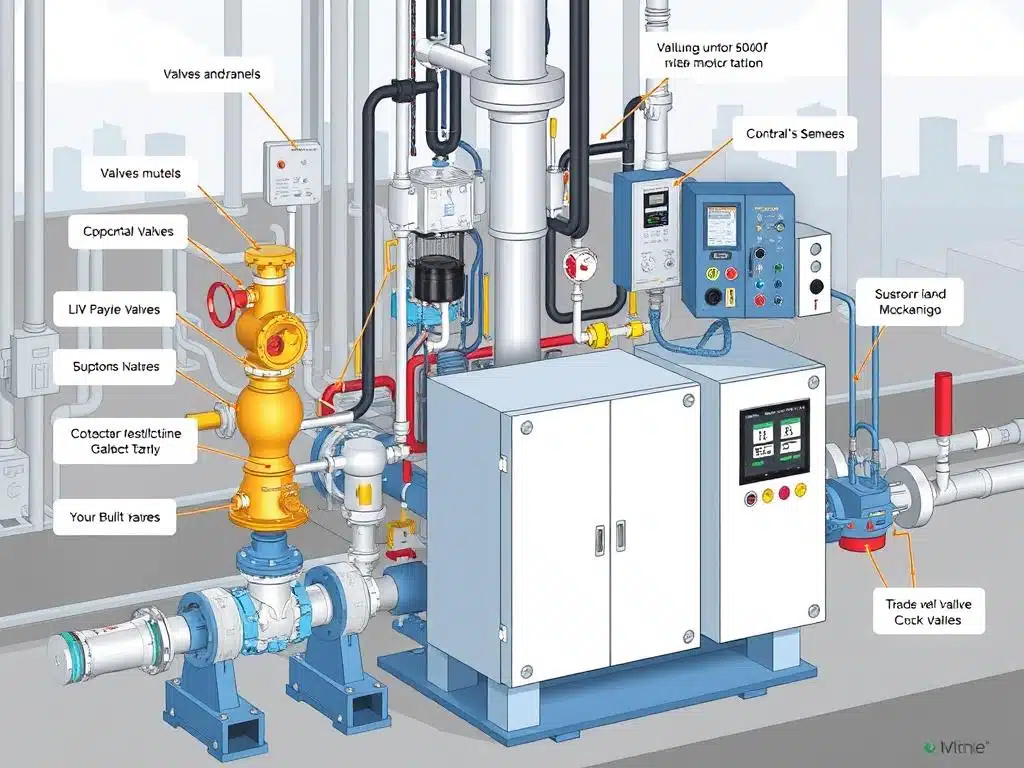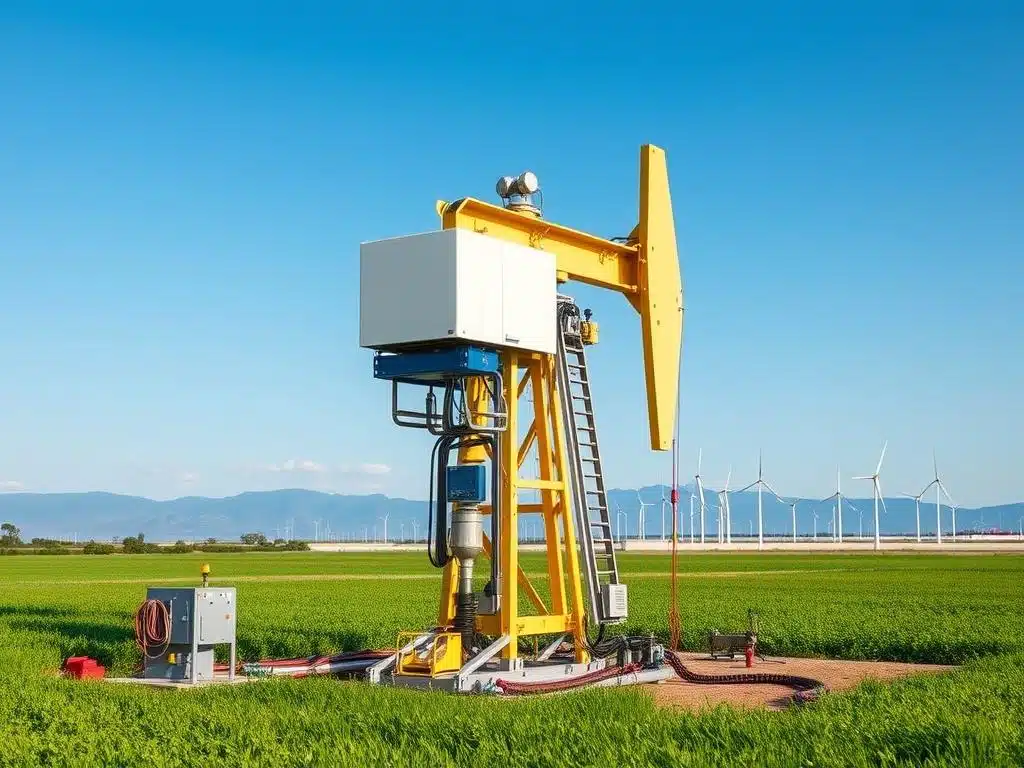Oil and gas companies rely on wellhead automation to keep operations running smoothly. This innovative technology has revolutionized the industry, transforming energy production. Let’s explore how wellhead automation is reshaping the landscape of oil and gas operations in this comprehensive wellhead automation guide.
Wellhead automation combines sensors, actuators, and control systems to optimize production processes. It monitors and regulates valves, pumps, and sensors automatically. This technology enhances safety, efficiency, and profitability in oil and gas operations.
Automation streamlines production, minimizes downtime, and boosts overall productivity. It provides operators with crucial data for informed decision-making. Quick responses to issues become possible, ensuring smoother operations.
A single well can generate an astonishing amount of data daily. This data influx necessitates intelligent completions and remote monitoring systems. Advanced platforms like Advantech Digital’s offering real-time data access from various devices.
Operators can view and control operations using smartphones, tablets, or laptops. This level of visibility and control is essential for effective management. It allows for rapid problem-solving and optimized production processes.
Key Takeaways
- Wellhead automation integrates sensors, actuators, and control systems to optimize production processes
- Automated monitoring and control of valves, pumps, and sensors improves safety, efficiency, and profitability
- A single well can generate data equivalent to 200 DVDs daily
- Intelligent completions and remote monitoring provide real-time data access from anywhere
- Advanced systems like PADPro offer intuitive interfaces and support multiple communication protocols
Introduction to Wellhead Automation Guide
Wellhead automation is a game-changer in the oil and gas industry. It optimizes production and slashes operating costs through advanced tech and smart control systems. Operators can manage wells efficiently, make smart investments, and maximize performance. Emerson leads the pack with solutions that boost profitability and streamline operations.
This technology balances safety and maintenance while keeping fields profitable. It integrates equipment, crews, schedules, data, processes, costs, and regulations. Automation ensures peak well performance and reduces manual data collection. ABB Totalflow XSeries products support various wellhead automation applications.
- Timer-based and process-based intermitting
- Production control with overrides
- Adaptive plunger lift control
- Nominations control
- Emergency shutdown control
- Reservoir/well test control
- Injection well control
- Simple and complex math/logic operations using IEC61131

ABB Totalflow’s Valve Control and Plunger Lift are two proven wellhead control schemes. Valve Control offers flow rate feedback control and continuous monitoring of override conditions. It allows manual valve control and interfaces with actuators using digital or analog outputs.
Plunger lift applications in XSeries products boost gas production and extend well life. They monitor dynamic parameters, support adaptive algorithms, and maintain data logs. The IEC61131 control language enables easy adaptation to new control algorithms.
Control features are accessible locally with PCCU32 or remotely with SCADA systems. These include WinCCU and ABB’s SCADAvantage, offering flexibility in monitoring and control.
| Feature | Specification |
|---|---|
| Operating Temperature Range | -40º C to 75º C |
| Electrical Power Options | 120V AC/60 Hz, 380V AC/60 Hz |
| Material Construction | Stainless steel, marine-grade aluminum, corrosion-resistant materials |
| Design Considerations | NACE compliance, extreme environments, customizable field requirements |
Emerson boasts over 150 man-years of experience in wellhead control panels (WHCP). They offer pump drive options up to 10,000 psi, including SCSSV, SSV, CV, UMV, and WV. Their solutions are built tough for extreme environments and can be tailored to specific field needs.
Benefits of Wellhead Automation
Wellhead automation revolutionizes oil and gas operations. It enhances efficiency, safety, and productivity through advanced technologies. Companies can optimize well sites and achieve impressive results with streamlined processes.

Safety is a primary advantage of wellhead automation. It reduces manual interventions and personnel exposure to hazards. Companies can see up to a 50% improvement in safety measures. This protects employees and maintains regulatory compliance.
Automation also reduces the risk of costly incidents. It creates a safer work environment for all involved. This leads to improved overall operations and peace of mind.
Improved Efficiency
Wellhead automation enhances operational efficiency significantly. It optimizes injection rates, reduces costs, and increases recovery efficiency. Studies show a 30% reduction in operational costs and 20% improvement in overall efficiency.
Automated asset management systems extend equipment lifespan. This reduces costs by up to 20% and maximizes return on investment. The benefits of automation are far-reaching and substantial.
Enhanced Production
Advanced technology at well sites boosts production. Early detection of issues like sand and erosion prevents leaks. It also minimizes environmental consequences. Automation can increase gas production by 1% through improved availability.
Operator optimization efforts contribute an additional 0.5% to gas production. Oil production sees similar gains: 1% from automation and 0.5% from optimization. These improvements lead to significant financial gains for well sites.
| Benefit | Percentage Improvement |
|---|---|
| Safety Measures | Up to 50% |
| Workforce Productivity | Up to 25% |
| Downtime Reduction | Up to 15% |
| Environmental Footprint Reduction | Up to 20% |
Data analytics and real-time monitoring further enhance wellhead automation. These tools can reduce downtime by up to 30%. They also improve equipment maintenance and production planning. Increased efficiency boosts productivity and reduces environmental impact.
Automation helps decrease the environmental footprint by up to 20%. This makes wellhead automation a win-win solution for both industry and environment. The benefits are clear and undeniable.
Key Components of Wellhead Automation Systems
Wellhead automation systems use advanced sensors, actuators, and control systems to optimize production. These components monitor critical parameters, regulate flow, and maintain wellhead health. Together, they ensure smooth operations and maximize efficiency.

Sensors
Sensors provide real-time data on various wellhead parameters. Pressure sensors measure fluid flow, detect leaks, and monitor reservoir conditions. Temperature sensors ensure optimal operating temperatures and minimize equipment damage.
Flow meters precisely measure oil, gas, and water flow rates. These include differential pressure meters, positive displacement meters, and Coriolis flow meters. They help optimize production and maintain regulatory compliance.
Actuators
Actuators control valves and pumps in wellhead automation systems. They enable remote adjustment of flow rates, pressure, and other critical parameters. Actuators come in pneumatic, hydraulic, and electric types.
Each type has advantages depending on the application. By precisely controlling valves and pumps, actuators maintain optimal production levels. They also respond quickly to changing conditions.
Control Systems
Control systems, like SCADA, form the brain of wellhead automation. They collect data from sensors, analyze it in real-time, and send control signals to actuators. SCADA enables remote monitoring and control of the wellhead.
These systems allow operators to make informed decisions and respond promptly to issues. They also facilitate data integration and analytics. This helps optimize production, predict maintenance needs, and enhance overall efficiency.
Advanced sensors, actuators, and control systems ensure safe, efficient, and reliable wellhead operations. They maximize production, minimize downtime, and provide valuable insights. These components work together seamlessly for continuous improvement.
Pressure Sensors in Wellhead Automation
Pressure sensors are crucial for efficient and safe wellhead automation operations. They monitor pressure levels in real-time, optimizing production and detecting potential issues. By integrating these sensors, operators can make informed decisions and prevent equipment breakdowns.
Various technologies are used in pressure sensors for wellhead automation. These include piezoelectric, capacitive, and strain gauge sensors. They’re designed to withstand harsh conditions in oil and gas applications, ensuring accurate measurements.
In the North Sea, high temperature/high pressure fields require specialized sensors. These must operate in extreme environments with fluid temperatures up to 197°C and pressures reaching 1155 bar.

Energy companies in the North Sea use advanced instrumentation for wellhead pressure monitoring. Parkers, a leading supplier, provides API 6A valves for direct flange mounting. These valves come in various flange classes based on annuli pressure ratings.
Custom Pro-Bloc valves with 5k and 10k flanges ensure accurate pressure measurement. Double-block-and-bleed needle valves are installed for pressure monitoring ports on wellhead assemblies and high-pressure protective systems.
Pressure sensors in wellhead automation offer numerous benefits. They’re easy to install, lightweight, and compact, requiring minimal modifications to existing equipment. These sensors help detect leaks promptly, preventing environmental damage and ensuring safety.
By monitoring pressure levels, operators can protect against overpressure. This safeguards the wellhead and associated components from damage caused by excessive pressure buildup. Proper pressure control optimizes production rates and the quality of extracted hydrocarbons.
Various pressure gauges are used at wellheads. These include mechanical gauges, electronic transmitters, and submersible transducers. They must withstand extreme temperatures, corrosive substances, and harsh environmental factors in offshore and desert locations.
Regular calibration and maintenance of pressure gauges are essential. This ensures accuracy and reliability in wellhead operations, contributing to overall safety and efficiency.
Temperature Sensors in Wellhead Automation
Temperature sensors are vital in wellhead automation systems. They provide accurate data to monitor well fluid and equipment temperatures. These sensors, like RTDs and thermocouples, help operators detect problems and optimize production.
They work with other sensors to enhance system reliability. This minimizes downtime and monitors critical equipment for temperature issues. These sensors can withstand harsh conditions with a service range of -40 °C to 270 °C.

RTDs and Thermocouples
RTDs and thermocouples are common temperature sensors in wellhead automation. RTDs offer high accuracy and stability. Thermocouples are known for wide temperature range and durability. Choosing between them depends on application, accuracy needs, and cost.
New sensor technology has led to maintenance-free options. These can replace mechanical parts and operate reliably for up to 10 years. The Rosemount X-well Technology with 648 Transmitter is an example of this advancement.
Monitoring Equipment Components
Temperature sensors are placed on various equipment components. They monitor thermal performance and detect potential issues. Key components and their monitoring capabilities include:
| Component | Monitoring Capability |
|---|---|
| H2S Sensors | Operating temperature range: -40 °F to +122 °F |
| O2 Depletion Sensors | Operating temperature range: -22 °F to +122 °F |
| CO Sensors | Operating temperature range: -22 °F to +122 °F |
| Pressure Sensors | Measurement range: up to 4,000 psi (275.8 bar) Gage, up to 10,000 psi (689.5 bar) Absolute |
Continuous temperature monitoring helps operators identify overheating issues quickly. This prevents costly equipment failures and production downtime. Temperature sensors, combined with analytics and maintenance strategies, boost wellhead automation efficiency.
Flow Meters in Wellhead Automation
Flow meters are vital in wellhead automation systems. They accurately measure fluid flow in production wells. These devices provide real-time data on oil, gas, and water production volumes and rates. This information helps operators optimize production and make informed decisions.

Recent studies show 80-85% of onshore crude production is documented through tank strapping. The U.S. is experiencing its highest level of liquids exploration in 40 years. This has increased demand for accurate flow measurement technologies.
Types of Flow Meters
Various flow meters are used in wellhead automation. Each type has its own strengths and limitations. Here are some common types:
- Differential pressure (DP) flow meters: These measure pressure drop across a pipe constriction. DP meters are widely used but have a low turndown ratio.
- Positive displacement flow meters: These count fixed fluid volume displacements. They’re highly accurate but may wear over time.
- Turbine flow meters: These use a spinning rotor to measure flow rate. They’re known for high accuracy and wide flow range.
- Electromagnetic flow meters: These use magnetic fields to measure conductive fluid velocity. They have no moving parts and handle various flow rates.
- Ultrasonic flow meters: These use sound waves to measure fluid velocity. Their accuracy ranges from 0.35% to 0.5%.
- Coriolis flow meters: These measure mass flow rate by analyzing tube vibration. They’re becoming popular due to their accuracy and lack of moving parts.
Choosing the Right Flow Meter
Selecting a flow meter depends on several factors. These include fluid type, flow rate range, pressure, and temperature. Accuracy requirements and installation constraints also matter.
Each oil field and well can have different production characteristics. Thorough testing and evaluation are essential before choosing a flow meter. For example, Coriolis meters were tested in Bakken shale and Saskatchewan heavy oil wells.
An error of 1% in measuring 300 million ft3 of gas per day can lead to a difference of about $2 million per year.
Accurate flow measurement is crucial in wellhead automation. Working with experienced professionals and trusted manufacturers is important. Proper selection, installation, and maintenance of flow meters can optimize production and maximize profitability.
Wellhead Automation Guide: Best Practices
Adopting industry best practices is vital for optimal wellhead automation performance. These strategies maximize automated control system benefits while reducing risks and downtime. Proper implementation ensures reliable and efficient operations.
Careful installation and commissioning of devices are crucial for wellhead automation success. This involves meticulous setup of sensors, actuators, and control systems. Accurate calibration and testing during commissioning prevent future complications.

Regular maintenance and calibration preserve wellhead automation system integrity. Proactive equipment health monitoring and upkeep extend component lifespans. This approach minimizes unexpected failures and ensures smooth operations.
Consider these maintenance best practices:
- Schedule routine inspections and calibrations
- Replace worn or damaged components promptly
- Keep detailed maintenance records for each device
- Provide ongoing training for maintenance personnel
Effective troubleshooting procedures are essential for wellhead automation success. A systematic approach to problem-solving significantly reduces downtime. Quick issue resolution maintains operational efficiency and productivity.
Implement these troubleshooting tips:
- Consult equipment manuals and documentation
- Analyze alarm logs and error codes
- Perform systematic tests to isolate the issue
- Collaborate with experienced technicians and engineers
Proactive monitoring and continuous improvement strategies optimize wellhead automation benefits. Advanced technologies and data analytics help predict potential issues. This approach enhances performance and prevents unexpected problems.
| Best Practice | Benefits |
|---|---|
| Proper Installation and Commissioning | Ensures devices function as intended and prevents future issues |
| Regular Maintenance and Calibration | Extends equipment lifespan and minimizes unexpected failures |
| Effective Troubleshooting Procedures | Reduces downtime by systematically identifying and resolving problems |
| Proactive Monitoring and Continuous Improvement | Optimizes performance and predicts potential issues before they occur |
By implementing wellhead automation best practices, we can ensure the safety, efficiency, and reliability of our operations while maximizing production and minimizing downtime.
Remote Monitoring and Control
Remote monitoring and control are vital in wellhead automation. These technologies optimize operations, enhance safety, and reduce costs. Operators can access real-time data and manage wellheads from a central location using wireless wellhead telemetry.
Remote monitoring and control offer numerous benefits. They increase safety by reducing on-site accident risks. Substantial cost savings on travel and maintenance expenses are achieved. Operational efficiency improves through prompt decision-making based on real-time data.
These technologies also enhance productivity levels due to optimized wellhead performance. They ensure compliance with environmental regulations through continuous monitoring of air quality and water levels.
SCADA Systems
SCADA systems are central to remote monitoring and control. These tools collect data from sensors and devices at the wellhead. They provide a centralized platform for monitoring and control.
SCADA systems enable real-time monitoring of key parameters like pressure, temperature, and flow rates. They detect anomalies and potential issues before escalation. Operators can remotely adjust settings and control equipment to optimize performance.
- Monitor key parameters such as pressure, temperature, and flow rates in real-time
- Detect anomalies and potential issues before they escalate
- Remotely adjust settings and control equipment to optimize performance
- Generate reports and analyze historical data for continuous improvement

Cloud Computing
Cloud computing has transformed data management in wellhead automation. It allows operators to access real-time data and applications from anywhere, anytime. Infrastructure can be scaled seamlessly to accommodate growing data volumes.
Cloud computing ensures data security and reliability through robust backup mechanisms. It facilitates collaboration among team members and stakeholders across different locations.
- Access real-time data and applications from anywhere, at any time
- Scale their infrastructure seamlessly to accommodate growing data volumes
- Ensure data security and reliability through robust backup and recovery mechanisms
- Collaborate with team members and stakeholders across different locations
Remote monitoring can reduce downtime and save costs and labor, providing critical insights across factory floors, equipment rooms, mining operations, utilities, water and wastewater operations, digital oil fields, and more.
Remote monitoring and control, SCADA systems, and cloud computing are revolutionizing wellhead automation. These technologies are transforming oil and gas operations management. The result is a safer, more efficient, and sustainable future for the industry.
Data Integration and Analytics
Data integration and analytics are revolutionizing wellhead automation. These tools unlock valuable insights from sensor data. Operators can now optimize production, detect anomalies, and make data-driven decisions. This approach boosts efficiency and profitability in unprecedented ways.
The oil and gas industry has seen transformative impacts. Automating data workflows with Fulcrum dramatically reduces labor costs. Clients save $8 to $18 for every dollar spent on this system.
Safety audits have become more efficient too. Snavely Forest Products reports a 75% improvement in recordkeeping efficiency. Carrington Risk’s CEO confirms faster, more accurate data gathering with Fulcrum.
- Manual data handling drains both time and money. Automating data workflows with Fulcrum slashes labor costs associated with data entry and processing, with clients seeing savings of $8 to $18 for every dollar spent!
- Using Fulcrum for safety audits improved recordkeeping efficiency by as much as 75% for every inspection, according to James Watts, Director of Health and Safety at Snavely Forest Products.
- Kristin Carrington, CEO of Carrington Risk, highlights that with Fulcrum, the data-gathering process is faster and more accurate, ensuring the export is right.
Data integration offers more than just cost savings. It allows organizations to scale without increasing manual workload. Great Lakes Wellhead, Inc. reports that public utilities can save 80% on inspection costs with Fulcrum.
Real-world examples demonstrate the power of these analytics:
| Company | Impact |
|---|---|
| GeoForce | Significantly enhanced utility pole inspections, decreasing manual entry errors and operational delays, enabling service expansion without increasing staff numbers. |
| TREKK | Optimized water utility inspections through detailed workflows, reducing manual entry needs, operational costs, and ensuring timely and accurate service provision. |
The oil and gas industry is embracing digital solutions and AI-powered analytics. These tools reduce project risks, carbon footprint, and total ownership costs. They also improve execution reliability and boost well economics.
Connected solutions enable real-time monitoring for operations. This includes remote maintenance and optimal wellhead performance tracking. These systems provide continuous analysis for better decision-making across oil and gas operations.
Intelligent solutions focus on combining software and hardware systems for continuous analysis, providing real-time information to optimize performance across various aspects of oil and gas operations.
Autonomous solutions integrate software and hardware seamlessly. They enhance performance in areas like directional drilling and chemical injection. Digital technologies drive resilience and high performance in oil and gas operations.
Predictive Maintenance in Wellhead Automation
Predictive maintenance revolutionizes wellhead automation by optimizing equipment performance and minimizing downtime. Advanced sensors, data analytics, and machine learning algorithms detect anomalies and predict potential failures. This proactive approach enhances the efficiency and reliability of wellhead operations.
Continuous condition monitoring of critical components is essential for predictive maintenance. Real-time data analysis identifies subtle performance changes that may indicate impending failures. This allows for scheduling maintenance during planned downtimes, reducing costly unplanned shutdowns.
Detecting Anomalies
Anomaly detection plays a crucial role in predictive maintenance for wellhead automation. Baseline performance metrics help identify deviations from normal operating conditions. Advanced algorithms analyze sensor data to detect slight anomalies indicating developing issues.
This early warning system enables proactive measures to address potential problems. By catching issues early, operators can prevent minor concerns from escalating into major failures.
Scheduling Maintenance
Effective maintenance scheduling maximizes the benefits of predictive maintenance. Insights from anomaly detection and condition monitoring help prioritize maintenance activities. This targeted approach allocates resources where they’re needed most, reducing unnecessary costs and minimizing production impact.
| Maintenance Approach | Annual Savings | Unplanned Downtime Reduction |
|---|---|---|
| Predictive, Data-Based | $34 million | 36% |
| Reactive | – | – |
Industry statistics show significant benefits of predictive maintenance. Operators using data-based approaches save $34 million annually and reduce unplanned downtime by 36%. These improvements lead to increased production and profitability in wellhead automation systems.
Predictive maintenance can identify impending equipment failures through data collection, resulting in a 36% decrease in unplanned downtime and a $34 million boost to the bottom line annually for operators.
Advancing predictive maintenance in wellhead automation requires investment in the right technologies and expertise. Partnering with experienced providers and fostering continuous improvement unlocks the full potential of this approach.
By embracing predictive maintenance, operators can drive sustainable success in the dynamic world of oil and gas production. The benefits extend beyond cost savings to improved reliability and efficiency across operations.
Cybersecurity Considerations for Wellhead Automation
Cybersecurity is crucial for wellhead automation systems in the oil and gas industry. The increasing connectivity of these systems demands robust security measures. Protecting critical infrastructure ensures smooth operations of wellhead automation systems.
A 2017 study highlighted industrial cybersecurity challenges for advanced oil and gas companies. Long asset life cycles, outdated inventories, and lack of unified security standards contribute to these issues. In 2016, 68% of surveyed organizations faced at least one cyber compromise.
Secure Communication Protocols
Implementing secure communication protocols is vital for wellhead automation cybersecurity. Encrypting data transmission and using VPNs protects sensitive information from unauthorized access. These measures ensure data confidentiality and integrity between wellhead automation components.
Industry-standard protocols like OPC UA and MQTT provide secure frameworks for data exchange. These protocols incorporate authentication, authorization, and encryption features. Leveraging these protocols establishes a robust foundation for protecting wellhead automation systems.
Access Control Measures
Stringent access control measures are critical for wellhead automation cybersecurity. Role-based access control (RBAC) ensures only authorized personnel can access specific system components. RBAC defines granular permissions based on user roles, minimizing unauthorized access risks.
Multi-factor authentication (MFA) adds an extra security layer. It requires multiple forms of identification before granting access. MFA can include passwords, biometric data, or hardware tokens. This measure significantly strengthens access control and safeguards against potential breaches.
| Cybersecurity Measure | Implementation | Benefits |
|---|---|---|
| Secure Communication Protocols | Encrypted data transmission, VPNs, OPC UA, MQTT | Protects sensitive data, ensures confidentiality and integrity |
| Access Control Measures | Role-based access control (RBAC), multi-factor authentication (MFA) | Restricts unauthorized access, enforces granular permissions, adds extra layer of security |
| Network Segmentation | Separating control networks from corporate networks, firewalls, VLANs | Isolates critical systems, contains potential breaches, reduces attack surface |
| Data Encryption | Encrypting data at rest and in transit, using strong encryption algorithms | Protects sensitive information, maintains data confidentiality, prevents unauthorized access |
Network segmentation is an effective cybersecurity measure for wellhead automation. Separating control networks from corporate networks creates an isolated environment. This can be achieved through firewalls and virtual local area networks (VLANs). Isolation contains potential breaches and reduces the attack surface.
“Cybersecurity is not just about protecting data; it’s about ensuring the safety and reliability of our critical infrastructure. In the oil and gas industry, a cyber attack on wellhead automation systems can have devastating consequences. It is our responsibility to prioritize cybersecurity and implement robust measures to safeguard our assets and operations.” – Industry Expert
Data encryption is fundamental to wellhead automation cybersecurity. Encrypting data at rest and in transit protects sensitive information. Strong encryption algorithms ensure intercepted data remains unreadable to attackers. This maintains data confidentiality and prevents proprietary information leakage.
Collaborating with industry experts enhances wellhead automation cybersecurity. Companies like IEB Media offer valuable insights on effective strategies. Partnering with such organizations helps address evolving cyber threats and secure wellhead automation systems.
Cybersecurity is critical for wellhead automation in the oil and gas industry. Implementing secure protocols, access controls, and encryption establishes a robust framework. Prioritizing cybersecurity ensures safety, reliability, and efficiency of wellhead automation systems. This approach unlocks the full potential of digital transformation in the industry.
Implementing Wellhead Automation: A Case Study
An offshore hub’s wellhead automation project highlights key benefits and best practices. The system monitored 16 wellheads using non-intrusive pipe clamp sensors for temperature tracking. It integrated over 40 wireless points, including Rosemount™ transmitters for temperature and pressure monitoring.
The network covered production, wellhead, receiver, fuel gas skid, and gas receiving across five platforms. Wireless monitoring eliminated technician trips, saving costs significantly. The system also reduced production losses and reporting errors, enhancing safety and efficiency.
Successful implementation hinged on stakeholder engagement, technology selection, and change management. FlowForma Process Automation was chosen for its user-friendliness and Microsoft cloud suite integration. The project began with a pilot for Non-Compliance Reporting in Quality Assurance.
Following the pilot, HR Onboarding/Offboarding and Performance Management tools were implemented. This approach allowed for gradual adoption and refinement of the automation processes.
“FlowForma helped fill in deficiencies without additional infrastructure investment, enabling the company to avoid investing in expensive new software for large-scale projects.” – CFO
The return on investment (ROI) was substantial. Compliance Reporting workflow improved traceability, saving time during audits. The solution enhanced processes across operations, engineering, QA, HR, and finance departments.
Automation and digitization led to increased production, reduced costs, and improved safety. These outcomes aligned with the organization’s goal of continuous process improvement.
This case study offers valuable lessons learned for companies exploring wellhead automation. Stakeholder engagement, technology selection, and change management are crucial for success. Data analytics and machine learning can predict part failures and optimize maintenance schedules.
Collaboration platforms like the Ignition Oil & Gas Collective enable knowledge sharing. Companies can learn from industry-specific insights, successes, and failures to drive continuous improvement in wellhead automation.
Future Trends in Wellhead Automation
Wellhead automation is evolving rapidly, driven by cutting-edge technologies transforming the industry. Future trends in this field will be shaped by artificial intelligence, machine learning, and IoT integration. These advancements will revolutionize wellhead operations monitoring, control, and optimization.
Market projections indicate impressive growth for the global Wellhead Valve market. An annual growth rate of 14.7% is expected from 2024 to 2031. This surge is fueled by smart wellhead valve adoption and emphasis on automation.
The Asia-Pacific region is set to dominate the market. It’s projected to hold approximately 40% market share in the coming years.
Artificial Intelligence and Machine Learning
AI and machine learning will revolutionize wellhead automation through advanced predictive analytics and optimization. These technologies enable systems to learn from vast data amounts and make real-time intelligent decisions. Operators can anticipate issues, optimize production, and minimize downtime using AI and machine learning.
Internet of Things (IoT) Integration
Internet of Things (IoT) integration is a key driver in wellhead automation’s future. It connects various devices and sensors, enabling real-time monitoring and control of operations. This technology gives operators unprecedented visibility into well performance, allowing for proactive maintenance and optimization.
“The integration of IoT and edge computing in wellhead automation is a game-changer. It enables real-time data processing and decision-making at the source, reducing latency and improving responsiveness.”
Edge computing is crucial for IoT integration in wellhead automation. It brings data processing closer to the source, reducing latency and enabling faster responses. This is vital for remote or offshore operations with limited connectivity.
Embracing these trends is essential for companies aiming to stay competitive in wellhead automation. Leveraging AI, machine learning, and IoT technologies unlocks new efficiency, safety, and productivity levels. This positions operators for success in the industry’s evolving landscape.
Conclusion
Wellhead automation is transforming the oil and gas industry. It offers numerous wellhead automation benefits, including optimized production, reduced costs, and enhanced safety. In Iran, where oil and gas are vital, these advantages are particularly significant.
Companies can gain a competitive edge by implementing automation best practices. Staying current with AI, machine learning, and IoT trends is crucial. These technologies will shape the industry’s future.
In Iran, MWHCPs are key to operational efficiency and minimizing downtime. However, challenges include geopolitical factors, technological barriers, and environmental issues. Adhering to API and ISO standards is essential for global competitiveness.
Wireless wellhead telemetry significantly improves safety standards. It reduces on-site accident risks and injuries. Companies using remote monitoring solutions can save up to 30% annually on travel and maintenance costs.
Real-time data enables timely decisions, improving operational efficiency by about 25%. Integrating wireless wellhead solutions boosts productivity by around 20%. Environmental sensors help ensure regulatory compliance, with improvement rates up to 15%.
Wellhead automation drives digital transformation in the oil and gas sector. It enhances safety, efficiency, and production. Embracing these technologies gives companies a competitive advantage in the evolving energy landscape.







1 thought on “Comprehensive Wellhead Automation Guide | Industry Tips.”
Comments are closed.